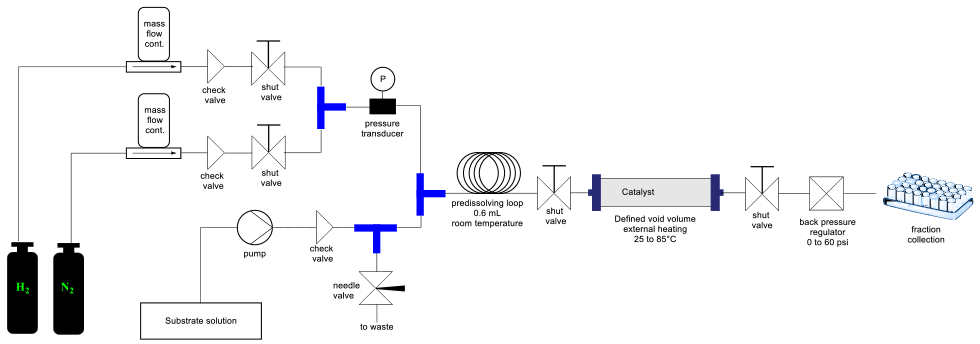Advantages of Continuous Flow over Traditional Batch Processes
Continuous flow offers many advantages over traditional batch processes. Often cited advantages are:
- Greater control over mixing and mass transfer
- Improved heat transfer
- Can often avoid the need for very low temperatures (-78ºC), high dilution and slow addition
- Efficient photochemical reactions
- Heterogeneous catalyzed reactions without the need of catalyst removal
- Safer processes
- Use of short lived or highly reactive intermediates
Continuous Flow Reactions offer greater volumes, simpler scale-up & reduced costs
Continuous flow allows a large amount of material to be processed in a small space (e.g., a typical fume hood). Scaling up to a larger flow reactor to reach higher throughput can be much simpler than scaling up a batch process, where factors like mass transfer, stirring, and heat dissipation rapidly become less favorable with increasing scale. Flow setups can also avoid the high cost of large reaction vessels.
Continuous Flow Reactions are safer & more versatile
Another significant advantage is safety. Continuous Flow Reactors (CFRs) allow for very efficient heat removal from exothermic processes while avoiding large reaction volumes. Compressed gasses in a flow allow for very high-pressure reactions to proceed without the safety concerns of pressurizing a large reactor vessel.
A wide range of chemistry can be adapted to flow with several types of CFRs. In addition to the well-known Plug-Flow Reactors, Continuous Stirred Tank Reactors (CSTRs) offer several advantages. With peristaltic pumping, CSTRs allow even heterogeneous reactions to be adapted to flow. CSTRs can be used in sequence and tailored to specific reaction profiles to optimize rate and selectivity.
J-STAR Research can adapt to your project’s specific requirements
J-STAR Research offers the expertise to adapt a wide variety of chemical processes to medium or small-scale continuous flow.
Below are some of the flow capabilities at J-star:
- Plug flow reactors with overall flow rates of 0-20 mL/min.
- Temperatures of -50°C to 150 °C
- Pressures of up to 100 psi
- Systems compatible with corrosive chemicals
- Continuous Stirred Tank Reactors (CSTRs) of 5-500 mL volume
- Mass flow meters for precise control of liquid and gas feeds
- Stainless-steel packed bed reactors
- Continuous photochemistry with a variety of commonly used wavelengths: 254, 311, 365 & 470 nm (expandable)
A recently employed example of a continuous flow reactor is shown in the following graph utilizing some of the discussed elements: Continuous Flow Reactor
Continuous Flow Reactor
